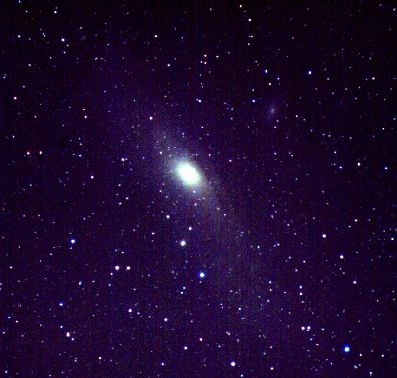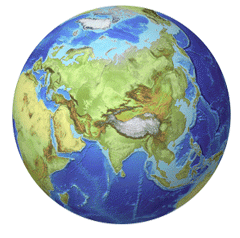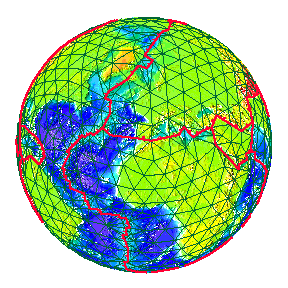 Adrift in the Cosmos
Adrift in the CosmosNavigating the site:
 The Universe is an unfolding story.
The Universe is an unfolding story.
"We begin our story about 13.7 billion years ago, when the universe emerged in the big bang. Then we follow the history of our small corner of it to look at the consequences of the formulation of the solar system , the moon, the globe of Earth on the organs, cells, and genes inside each of us."
"Bodies are organized like a set of Russian nesting dolls: tiny particles make atoms, groups, of atoms make molecules, and molecules assemble an interact in different ways to compose our cells, tissues, and organs. Each level of organization brings new properties that are greater than the sum of its parts."
Neil Shubin, The Universe Within. (2013). p. 14-16 & 17.
"I would answer that one's first appreciation is a sense that the creation is still going on, that the creative forces are as great and as active today as they have ever been, and that tomorrow's morning will be as heroic as any in the world. Creation is here and now."
Henry Beston, The Outermost House, p. 220.
The unity of nature arises from the common origins of all features comprising our physical existence.
The late Carl Sagan, said we are really "star stuff," composed of elements that have their atomic composition because they are born of the fusion process that fires all the stars we see in the night sky. But recently scientists have recognized that most of the universe is not observable, because it is what we now call "dark matter."
Drawn here: neutrons decay emitting electrons and photons.
What we can see of the cosmos is explained in terms of scales and contingent stages of development. From these sequential stages in which time emerges from the simple eternity of a "singularity" and beats to a constant rhythm of neutron decay. When neutrons decay these subatomic particles release electrons and in these subsequent
emissions of photons that –on our planet– give rise to and continuously feed the bacteria and plants whose entropy laden biological rhythms sustain all other living creatures including our own lives.
Appropriate symbolism to represent the world.
| next | back to start |
Not a static body, but inherently transformed by planetary processes together involving geology and biology.
An origin story with a unique symbol for nature
by Joseph Siry We are sentient creatures that symbolically represent our experiences of the world to ourselves. We do this so that we may compare our impressions with other observers' perceptions. By contrast and comparison each human creature conveys information about her surroundings to other people. Our skillfully articulate creation of language requires us to think with a rich symbolic imagery of the world we encounter. Expressing the depth of that encounter with the world and its various living things is one purpose of telling one another stories about nature. Yet we must be careful to use symbols that adequately reflect the conditions of nature to which we are subject as people, families and social groups.
On any journey one needs a guide and some great books are the guide of our steps down the entropy ridden tunnel of time that wraps so tightly around our mortal existence. The indisputably original thinkers whose minds apprehended an entirely new vision of reality have left to us an unbelievably rich legacy of thoughts, analyses, and methodical proofs that our living earth is a fundamental anomalous piece in an otherwise dark and distant universe of 100 billion galaxies. These are clusters of stars both larger and smaller than our sun, an oasis of radiant energy across the curvature of a vast space. The overwhelming expanse of our solar system dwarfed as it is by the milky-way galaxy is all but lost in this expanding menagerie of gas fusion engines called stars that explode providing us with the chemical of existence and the special atoms in the molecules of life. We are as the late Carl Sagan reminded us "star stuff" because we are made of the recycled debris of bursting stars!
Fortunate are we to find ourselves in the midst of a water cooled and gas heated planet that harbors more life on the surface, in a few meters of earth, air and water than anywhere else in the gravitational immensity of planetary sphere that is the whole earth. This is because the molten interior of nickel and iron surfacing as magma in volcanoes is far too hot and nutrient poor for life to proliferate as it has for billions of years on the Earth's surface. Where the lava or extruded magma meets the sea an explosion of heat and an opportunity for life in the frigid waters of the abyss. The planet's boiling essence spews forth enriching the seas with a potential habitat within which life might thrive -- "And his spirit moved across the face of the deep." From the primal stress of cold dark water and hot congealing lava meeting beneath the frigid ocean's sightless depths bacteria eat their way through the nutrient rich sulfur vents from submarine volcanoes rising up from the ebony abyss of otherwise stillborn seas.
Life has grabbed a stubborn and uncommonly tenacious hold on the character and descendants of this planet's myriad assembly of living creatures. From single cells, to flowering plants the variety of natural living things is reduced to five great domains or kingdoms of life depending on how they acquire a living, their complexity and their formal taxonomic distinctions.
These five kingdoms, like the individual fingers of a working hand represent the life of this planet. Bacteria and plants make up the forefinger and thumb of this dexterous hand.
Fungus is the middle finger, single-celled plants or animals the ring finger, and multi cellular animals are the pinkie. Yes, the irony of this hand of nature is that the smallest, most exposed finger represents the enormous range of different animals that seem to overwhelm our ideas about what makes up nature. Animals appeal to us because we are one of their kin. The animal world rests on a mightily complex and sublime stage or foundation of bacteria, fungi and plants; this symbol conveys a new frame that is an ecological perspective on the hand of life.
Animals are at the mercy of climatic and geographical conditions but they are even more subject to limitations imposed on them by the creatures upon whom they depend for food (prey), fuel (oxygen), fiber (cellulose), and fodder ( grain ). The world obviously does not appear to be a functioning hand but the five kingdoms of life is the truly "hidden hand" in the symbolic imagery that is needed to reform our vision of the world.
This revolution in our story about nature requires us
to redefine and articulate our duties to life's survival while informing us of our debt to the vast experience of life on a remote planet orbiting a tiny star in the distant tangential arm of the vast Milky way galaxy. Welcome aboard the Terra craft as it journeys around the sun and its crew explores the story of the universe, its order, proportions and origins.
What does self creating mean?
Edward O. Wilson explains that this exquisitely functional and beautiful earth harbors diverse forms of life that took billions of years to descend from a common collection of ancestral protoplasm (living
tissues). This is the vast, sublime and as yet unfolding story of our origins and order. Ultimately life is an urge, perhaps the underlying quest of the universe to understand itself in a revealing manner to an astute observer.
Not all places on Earth harbor the same diverse patterns of life. There is more variety in a single square mile of Brazil, Columbia, Costa Rica or Panama than in the entire expanse of the British Isles. The areas of the tropics including South America, Central Africa, Indonesia, and Southeast Asia tend to have a greater variety of related species both on land and in the shallow seas surrounding these prolific places.
While there exists no place on earth that is truly devoid of life, the concept of biological diversity suggests variety of different living creatures. Where there exists a variety of conditions in places for creatures to dwell (habitats) biologists value the many different species that occur because each tells us something about the biophysical constraints life overcomes to enrich these terrains. In other places such as the islands and waters surrounding Indonesia, many species of the same genus or family may flourish. This is called species richness and among plants and insects of the tropical rainforests that form of biological diversity is unmatched. Other places harbor so much life, such as the grasslands of the African Serengeti, that sufficient genetic diversity exists among predators and their prey to assure healthy populations. Thus directly, genetic variety leads to a healthy species, and indirectly the existence of numerous related species are indications of a health place. When an exceptional number of places coexist there are three different means of measuring and defining biological diversity. Because such biological wealth is manifest despite changing geological and climate conditions, new ways of thinking about life on Earth have become far more widespread since the 1920s when the concept of the biosfera was conceived as the entire realm of life on our living planet.
![]()
Genetics Index | What makes genetics significant? | History of Genetics | DNA discovery | RNA | Resistance| Visual images
Genetics | Science Index | Population Index | Global Warming Index | Nature Index | Brief | Site Analysis






